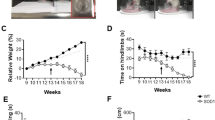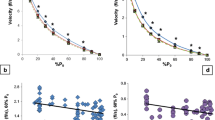Abstract
Motor function in humans can be characterized with tests of locomotion, strength, balance, and endurance. The aim of our project was to establish an analogous test battery to assess motor function in mice. Male C57BL/6 mice were studied at 3 (n = 87), 20 (n = 48) and 26 (n = 43) months of age. Tests assessed locomotion, strength, balance/coordination, and endurance capacity in mice. Motor function was reduced in the older groups of mice for the locomotion, strength, and endurance subdomains (p < 0.001). As indicated with a summary score, motor function declined by 7.4 % from 3 to 20 months and by 13.5 % from 20 to 26 months. Based on comparison with previously published data in humans, the magnitude and relative time course of changes were similar in mice and humans in each subdomain except balance/coordination. Power calculations confirmed that the age-associated differences depicted by several of the individual tests and domain summary scores would be sufficient to assess the efficacy of interventions aimed at prevention or treatment of motor dysfunction with aging. The current study describes a mouse model that characterizes age-associated changes in clinically relevant domains of motor function and indicates that the preclinical model can be used to test strategies to attenuate age-associated declines in motor function.




Similar content being viewed by others
References
Altun M, Bergman E, Edstrom E, Johnson H, Ulfake B (2007) Behavioral impairments of the aging rat. Physiol Behav 92:9111–9923
Anisimov VN, Zabezhinski MA, Popovich IG, Pliss GB, Bespalov VG, Alexandrov VA, Studov AN, Anikin IV, Alimova IN, Egormin PA, Panchenko AV, Piskunova TS, Semenchenko AV, Tyndyk ML, Yurova MN (2012) Rodent models for the preclinical evaluation of drugs suitable for pharmacological intervention in aging. Expert Opin Drug Discov 7(1):85–95
Bickford PC, Gould T, Briederick L, Chadman K, Pollock A, Young D, Shukitt-Hale B, Joseph J (2000) Antioxidant-rick diets improve cerebellar physiology and motor learning in aged rats. Brain Res 866:211–217
Brach JS, VanSwearingen JM (2002) Physical impairment and disability: relationship to performance of activities of daily living in community-dwelling older men. Phys Ther 82:752–761
Buchman AS, Wilson RS, Boyle PA, Buenias JL, Bennet DA (2007) Change in motor function and risk of mortality in older persons. J Am Geriatr Soc 55:11–19
Cabe PA, Tilson HA, Mitchell CL, Dennis R (1978) Simple recording grip strength device. Pharmacol Biochem Behav 8(1):101–102
Careau V, Bininda-Emonds ORP, Ordonez G, Garland T (2012) Are voluntary wheel running and open-field behavior correlated in mice? Different answers from comparative and artificial selection approaches. Behav Genet 42:830–844
Carter CS, Sonntag WE, Onder G, Pahor M (2002) Physical performance and longevity in aged rats. J Gerontol A Biol Sci Med Sci 57A(5):B193–B197
Carter CS, Marzetti E, Leeuwenburgh C, Manini T, Foster TC, Groban L, Scarpace PJ, Morgan D (2012) Usefulness of preclinical models for assessing the efficacy of late-life interventions for sarcopenia. J Gerontol A Biol Sci Med Sci 67A(1):17–27
Cho B, Scarpace D, Alexander NB (2004) Tests of stepping as indicators of mobility, balance and fall-risk in balance-impaired older adults. J Am Geriatr Soc 52:1168–1173
Cooper R, Kuh D, Cooper C, Gale CR, Lawlor DA, Matthews F, Hardy R, FALCon and HALCyon Study Teams (2011) Objective measures of physical capability and subsequent health: a systematic review. Age Ageing 40:14–23
de Fiebre NEC, Sumien N, Forster MJ, de Fiebre CM (2006) Spatial learning and psychomotor performance of C57BL/6 mice: age sensitivity and reliability of individual differences. AGE 28:235–253
Enoka RM, Christou EA, Hunter SK, Kornatz KW, Semmler JG, Taylor AM, Tracy BL (2003) Mechanisms that contribute to differences in motor performance between young and old adults. J Electromyogr Kinesiol 13(1):1–12
Fahlström A, Zeberg H, Ulfake B (2012) Changes in behaviors of male C57BL/6J mice across adult life span and effects of dietary restriction. AGE 34:1435–1452
Forster MJ, Lal H (1999) Estimating age-related changes in psychomotor function: influence of practice and of level of caloric intake in different genotypes. Neurobiol Aging 20:167–176
Fried LP, Guralnik JM (1997) Disability in older adults: evidence regarding significance, etiology and risk. J Am Geriatr Soc 45:92–100
Fries JF (2003) Measuring and monitoring success in compressing morbidity. Ann Intern Med 139(5):455–459
Guralnik JM, Simonsick EM, Ferucci L, Glynn RJ, Berkman LF, Blazer DG, Scherr PA, Wallace RB (1994) A short physical performance battery assessing lower extremity function: association with self-reported disability and prediction of mortality and nursing home admission. J Gerontol 49(2):M85–M94
Guralnik JM, Ferrucci L, Simonsick EM, Salive ME, Walace RB (1995) Lower extremity function in persons over the age of 70 as a predictor of subsequent disability. N Engl J Med 332:556–561
Guralnik JM, Ferrucci L, Pieper CF, Leveille SG, Markides KS, Ostir GV, Studenski S, Berkman LF, Wallace RB (2000) Lower extremity function and subsequent disability: consistency across studies, predictive models, and value of gait speed alone compared with the short physical performance battery. J Gerontol A Biol Sci Med Sci 55:M221–M231
High KP, Akbar AN, Nikolich-Zugich J (2012) Translational research in immune senescence: assessing the relevance of current models. Semin Immunol 24(5):373–382
Ingram DK (1983) Toward the behavioral assessment of biological aging in the laboratory mouse: concepts, terminology, and objectives. Exp Aging Res 9(4):225–238
Ingram DK (1988) Motor performance variability during aging in rodents. Assessment of reliability and validity of individual differences. Ann NY Acad Sci 515:70–96
Ingram DK, Reynolds MA (1986) Assessing the predictive validity of psychomotor tests as measures of biological age in mice. Exp Aging Res 12(3):155–162
Joseph JA, Bartus RT, Clody D, Morgan D, Finch C, Beer B, Sesack S (1983) Psychomotor performance in the senescent rodent: reduction of deficits via striatal dopamine receptor up-regulation. Neurobiol Aging 4(4):313–319
Joseph JA, Shukitt-Hale B, Denisova NA, Bielinski D, Martin A, McEwen JJ, Bickford PC (1999) Reversals of age-related declines in neuronal signal transduction, cognitive, and motor behavioral deficits with blueberry, spinach, or strawberry dietary supplementation. J Neurosci 19(18):8114–8121
Kirkland JL (2013) Translating advances from the basic biology of aging into clinical application. Exp Gerontol 48:1–5
Kirkland JL, Peterson C (2009) Healthspan, translation, and new outcomes for animal studies of aging. J Gerontol A Biol Sci Med Sci 64(2):209–212
Kulesskaya N, Rauvala H, Voikar V (2011) Evaluation of social and physical enrichment in modulation of behavioural phenotype in C57BL/6J female mice. PLoS ONE 6(9):e24755. doi:10.1371/journal.pone.0024755
Manini T, Visser M, Won-Park S, Patel KV, Strotmeyer ES, Chen H, Goodpaster B, De Rekeneire N, Newman AB, Simonsick EM, Kritchevsky SB, Ryder K, Schwartz AV, Harris TB (2007) Knee extension cutpoints for maintaining mobility. J Am Geriatr Soc 55:451–457
Manton KG, Gu Xi‐Liang, Ullian A, Tolley HD, Headen AE, Lowrimore G (2009) Long‐term economic growth stimulus of human capital preservation in the elderly. PNAS 106(50):21080–21085
Markowska AL, Breckler SJ (1999) Behavioral biomarkers of aging: illustration of a multivariate approach for detecting age-related behavioral changes. J Gerontol A Biol Sci Med Sci 54:B549–B566
Miquel J, Blasco M (1978) A simple technique for evaluation of vitality in aging mice, by testing their muscular coordination and vigor. Exp Gerontol 13:389–396
Montiglio PO, Garant D, Thomas D, Réale D (2010) Individual variation in temporal activity patterns in open-field tests. Anim Behav 80:905–912
Newman AB, Simonsick EM, Naydeck BL, Boudreau RM, Kritchevsky SB, Nevitt MC, Pahor M, Satterfield S, Brach JS, Studenski SA, Harris TB (2006) Association of long‐distance corridor walk performance with mortality, cardiovascular disease, mobility limitation, and disability. JAMA 295:2018–2026
Olshansky SJ, Goldman DP, Zheng Y, Rowe JW (2009) Aging in America in the twenty-first century: demographic forecasts from the MacArthur Foundation Research Network on an Aging Society. Milbank Q 87(4):842–862
Rae MJ, Butler RN, Campisi J et al (2010) The demographic and biomedical case for late-life interventions in aging. Sci Transl Med 2:40cm21
Rantanen T, Guralnik JM, Foley D, Masaki K, Leveille S, Curb JD, White L (1999) Midlife grip strength as a predictor of old age disability. JAMA 281:558–560
Rantanen T, Masaki K, He Q, Ross GW, Wilcox BJ, White L (2012) Midlife muscle strength and human longevity up to age 100 years: a 44-year prospective study among a decedent cohort. AGE 34:563–570
Reuben DB, McCreath HE, Bohannon RW, Want YC, Bubela DJ, Beaumont J, Rine RM, Lai JS, Gershon RC (2013) Motor assessment using the NIH Toolbox. Neurology 80(11 S3):S65–S75
Rikli RE, Jones CJ (1999) Development and validation of a functional fitness test for community‐residing older adults. J Aging Phys Act 7:129–161
Shukitt-Hale B, Cheng V, Joseph JA (2009) Effects of blackberries on motor and cognitive function in aged rats. Nutr Neurosci 12(3):135–140
Simonsick EM, Newman AB, Nevitt MC, Kritchevsky SB, Ferrucci L, Guralnik JM, Harris T (2001) Measuring higher level physical function in well-functioning older adults: expanding familiar approaches in the Health ABC Study. J Gerontol A Biol Sci Med Sci 56A(10):M644–M649
Stanaway FF, Gnjidic D, Blyth FM, Le Couteur DG, Naganathan V, Waite L, Seibel MJ, Handelsman DJ, Sambrook PN, Cumming RG (2011) How fast does the Grim Reaper walk? Receiver operator characteristics curve analysis in healthy men aged 70 and older. BMJ 343:d7679
Statistics FIFoA-R (2008) Older Americans 2008: key indicators of wellbeing. U.W. Government Printing Office, Washington
Studenski S, Perera S, Patel K, Rosano C, Faulkner K, Inzitari M, Brach J, Chandler J, Cawthon P, Connor EB, Nevitt M, Visser M, Kritchevsky S, Badinelli S, Harris T, Newman AB, Cauley J, Ferrucci L, Guralnik J (2011) Gait speed and survival in older adults. JAMA 305(1):50–58
Sumien N, Sims MN, Taylor HJ, Forster MJ (2006) Profiling psychomotor and cognitive aging in four-way cross mice. AGE 28:265–282
Verstergaard S, Patel KV, Walkup MP, Pahor M, Marsh AP, Espeland MA, Studenski S, Gill TM, Church T, Guralnik JM (2009) Stopping to rest during 400-meter walk and incident mobility disability in persons with functional limitations. J Am Geriatr Soc 57:260–265
Acknowledgments
The authors thank Mike Pont Carpentry, LLC, for design, development, and construction of customized experimental apparatus (Mike Pont Carpentry, LLC, Boulder, Colorado; mikepontcarpentry.com). This work was supported by NIH AG013038 (DRS).
Author information
Authors and Affiliations
Corresponding author
About this article
Cite this article
Justice, J.N., Carter, C.S., Beck, H.J. et al. Battery of behavioral tests in mice that models age-associated changes in human motor function. AGE 36, 583–595 (2014). https://doi.org/10.1007/s11357-013-9589-9
Received:
Accepted:
Published:
Issue Date:
DOI: https://doi.org/10.1007/s11357-013-9589-9




